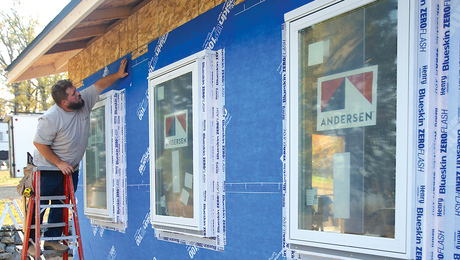I have a couple applications where I would like to retrofit hydronic heat into rooms that I cannot do via in-floor pex. I’ve gotten mixed opinions from others about running PEX tubing in walls or even ceilings. Google searches haven’t provided much for examples, so I am wondering if there are any resources or suggestions for a DIYer exploring this method? Most of my applications would be in the wall, both external and internal walls. The external walls would be heavily insulated, free of thermal bridges and well air-sealed, with available room on the interior side of the insulation to run the PEX in the stud bays. No drywall has been installed yet.
thanks



















Replies
A number of years ago they did this on TOH
I think that it was on this project in the mudroom.
http://www.thisoldhouse.com/toh/tv/house-project/overview/0,,198078,00.html
And I believe that I have seem large flat panel "radiators".
William the Geezer, the sequel to Billy the Kid - Shoe
This book isn't cheap, but it has everything you will need to know to design your system. It covers radiant wall panels as well as radiant ceiling panels. I am in the process of designing my own system and I could not have done it without this book.
http://www.amazon.com/Hydronic-Heating-Residential-Commercial-Buildings/dp/0766816370/ref=sr_1_1?ie=UTF8&s=books&qid=1233008505&sr=1-1
These are photo of heated wainscoting we did in our current reno project...
http://forums.invision.net/Attachment.cfm?1.jpg&CFApp=2&Attachment_ID=36492
http://forums.invision.net/Attachment.cfm?2.jpg&CFApp=2&Attachment_ID=36493
http://forums.invision.net/Attachment.cfm?5.jpg&CFApp=2&Attachment_ID=36496http://forums.invision.net/Attachment.cfm?Finished 5Flook.jpg&CFApp=2&Attachment_ID=36498
http://forums.invision.net/Attachment.cfm?Bath.jpg&CFApp=2&Attachment_ID=36497
Thanks for the responses. Looking at RBean's wainscotting application brings up my main question- How do you estimate the heat transfer with the hydronic system? The in-floor applications are traditionally embedded in concrete or use heat transfer plates to pull the heat out of the tubing and deliver it to the floor. The few examples of in-wall systems that I have seen do not do this- the tubing is just run between the stud bays. RBean put it in wood track, but i don't see any aluminum transfer plates. Are there any calcs for heat transfer from PEX to air, when done this way?
thanks!Shawn
RBean's wood track appears to be Quiktrak, a product by Wirsbo. Google it and you will see that there are in fact heat tranfer plates built into the panels. You can also just order individual aluminum heat transfer plates and rip sheets of plywood to make your own radiant panels. There are calculations to determine heat output. First thing you need to do is determine the heat loss of the area you are trying to heat.
If your curiosity is taking you down the do-it-yourself design path …this will get you started…
{[(Load, Btu/hr) / (panel area, sf)]/ Heat Transfer Coefficient for walls}+Room Temp, deg F = Surface Temp of Panel, deg F
Ex. What is the required surface temp of a radiant wall with a heat transfer coefficient of 1.4, given a heating load of 10,000 Btu/hr and an available surface area of 200 s.f.?
[(10,000 / 200) / 1.4 ] + 70 = 106 deg F
For other heat transfer coefficients see page 52, Table 1: Total heat exchange coefficient (convection + radiation) between surface and space for heating and cooling, from this article:http://www.ashrae.org/search/?q=vertically+integrated+systems+in+stand+alone&Submit=Go%21&shortcut=%23
For additional examples on how to use the heat transfer coefficients and to learn more about the 12 steps in designing radiant systems go to this link:http://www.healthyheating.com/Page%2055/Definitions/HTC.htm
If you want to learn how to actually specify tube, tube spacing and fluid temps based on the panel construction you’ll have to get thee self to a school or hire someone to do this for you (Rob from NRT hangs around this site and would be one source to consider for help).
The system shown in the photo's runs on weather compensation delivering up to 130 deg F at -40 deg F. We used non electric thermostatic room controls.
Try the attached picture. 1x3 strapping, light gauge plates, PEX-AL-PEX tubing. all assemblies must be well insulated behind.cheap and easy. 16" o.c. ceiling and 12" o.c. wall to maximize coverage in a limited area. for wall though, I prefer radiators, as no one will forget and put an entertainment center in front of it or nail into it.-------------------------------------
-=Northeast Radiant Technology=-
Radiant Design, Consultation, Parts Supply
http://www.NRTradiant.com
Thanks, this looks very easy to do. Where can I find data on heat xfer rates for pex, to calculate how much tubing I need for a given space?
thanks!Shawn
For the most part it seems like a fine ideal, but you got to remember that it is far more likely for someone to come along later and drive a nail or screw into a wall than into a floor.
Just a heads up.
DC